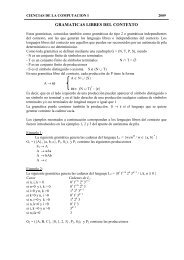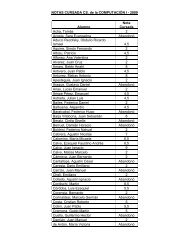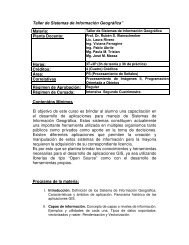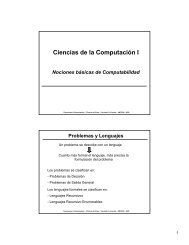Libro de Resúmenes / Book of Abstracts (Español/English)
Libro de Resúmenes / Book of Abstracts (Español/English)
Libro de Resúmenes / Book of Abstracts (Español/English)
Create successful ePaper yourself
Turn your PDF publications into a flip-book with our unique Google optimized e-Paper software.
Resumenes 61<br />
Re<strong>de</strong>s <strong>de</strong> mapas acoplados em sistemas<br />
biológicos <strong>de</strong> reação-difusão<br />
Luiz Alberto Díaz Rodrigues 1 , Maria Cristina Varriale 2 e Joceliane da Cas 2<br />
1 Departamento <strong>de</strong> Matemática, UFSM Santa Maria, RS, Brasil<br />
luizdiaz@smail.ufsm.br<br />
2 Instituto <strong>de</strong> Matemática, UFRGS Porto Alegre, RS, Brasil<br />
cris@mat.ufrgs.br<br />
Re<strong>de</strong>s <strong>de</strong> Mapas Acoplados (“Coupled Map Lattices”) são mo<strong>de</strong>los nos<br />
quais o espaço e o tempo são representados por variáveis discretas<br />
enquanto as variáveis <strong>de</strong> estado são <strong>de</strong>scritas por <strong>de</strong>nsida<strong>de</strong>s contínuas.<br />
Tais mo<strong>de</strong>los, que representam uma po<strong>de</strong>rosa ferramenta para analisar<br />
padrões espaciais e temporais resultantes <strong>de</strong> interações biológicas,<br />
constituem-se <strong>de</strong> um reticulado <strong>de</strong> equações a diferenças acopladas. Como<br />
o espaço e o tempo são discretos em sua formulação, tais mo<strong>de</strong>los são<br />
menos precisos do ponto <strong>de</strong> vista quantitativo do que mo<strong>de</strong>los <strong>de</strong> reaçãodifusão.<br />
No entanto, como eles po<strong>de</strong>m ser formulados diretamente em<br />
termos das escalas espaciais e temporais dos processos envolvidos, po<strong>de</strong>m<br />
revelar importantes padrões qualitativos.<br />
O objetivo principal <strong>de</strong>ste trabalho, portanto, é estudar Re<strong>de</strong>s <strong>de</strong><br />
Mapas Acoplados para simulação <strong>de</strong> sistemas <strong>de</strong> reação-difusão em<br />
Dinâmica Populacional. Estes mo<strong>de</strong>los representam aproximações <strong>de</strong><br />
mo<strong>de</strong>los contínuos <strong>de</strong> reação-difusão e são especialmente projetados para<br />
experimentação interativa, o que permite testar uma gran<strong>de</strong> varieda<strong>de</strong> <strong>de</strong><br />
mo<strong>de</strong>los e parâmetros.<br />
Palavras-Chave: Re<strong>de</strong>s <strong>de</strong> Mapas Acoplados, Sistemas <strong>de</strong> Reação-<br />
Difusão.<br />
Coupled map lattices in<br />
reaction-diffusion systems<br />
Coupled Map Lattices are approaches to mo<strong>de</strong>l population<br />
interactions. This type <strong>of</strong> formulation consi<strong>de</strong>rs space and time as discrete<br />
and state variables (population <strong>de</strong>nsities) as continuous. They are<br />
formulated as a system <strong>of</strong> difference equations in a coupled map lattice.<br />
Though it may seem that discrete mo<strong>de</strong>ls are less precise than the<br />
corresponding continuous reaction-diffusion mo<strong>de</strong>ls, we can take some<br />
advantage because they can be directly formulated in terms <strong>of</strong> spatial and<br />
temporal scales <strong>of</strong> the involved process, and then revealing important<br />
qualitative patterns.<br />
The main goal <strong>of</strong> this work is to analyze Coupled Map Lattices mo<strong>de</strong>ls,<br />
to simulate biological reaction-diffusion systems. These mo<strong>de</strong>ls represent<br />
approximations <strong>of</strong> reaction-diffusion continuous mo<strong>de</strong>ls and have been<br />
specially <strong>de</strong>signed to allow interactive experimentation. Thus, they enable<br />
us to check a large variety <strong>of</strong> dynamics and parameters.



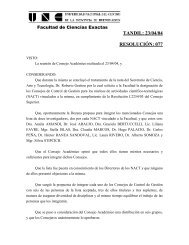
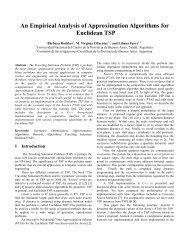
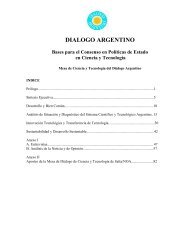
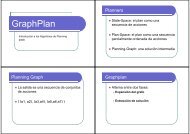
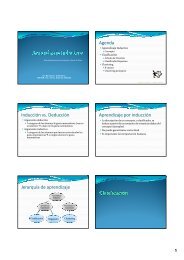
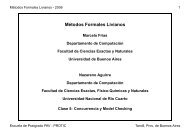
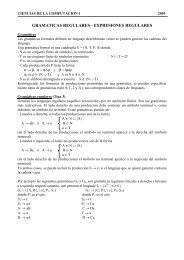

![Clase 13 [pdf]](https://img.yumpu.com/19616969/1/190x245/clase-13-pdf.jpg?quality=85)

